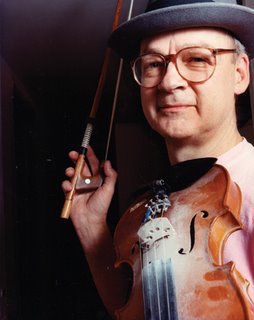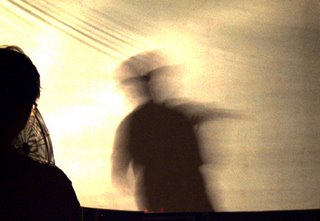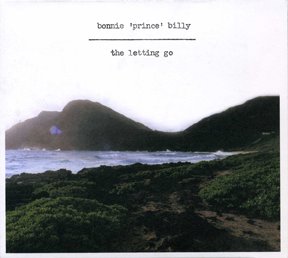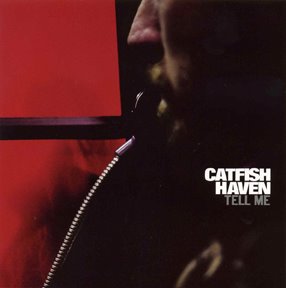A Conversation with Tony Conrad
 Delving into any recording that bears the mark of the seminal avant-garde label Table of the Elements requires a deeper level of listening than the average pop, jazz or modern classical record. The label’s catalogue is a celebration of experimentation and minimalism, but not by the standards of Philip Glass or Steve Reich’s sense of narcotic repetition. Rather, each release is an exploration of the imperfections of a single sound grinding into infinity, and the uncharted dimensions contained within each anomaly in tone and texture. Everyone from John Cale to John Fahey to Captain Beefheart have found a home for the most unorthodox chapters of their careers under TotE’s wings — chapters considered too far out by most labels’ standards.
Delving into any recording that bears the mark of the seminal avant-garde label Table of the Elements requires a deeper level of listening than the average pop, jazz or modern classical record. The label’s catalogue is a celebration of experimentation and minimalism, but not by the standards of Philip Glass or Steve Reich’s sense of narcotic repetition. Rather, each release is an exploration of the imperfections of a single sound grinding into infinity, and the uncharted dimensions contained within each anomaly in tone and texture. Everyone from John Cale to John Fahey to Captain Beefheart have found a home for the most unorthodox chapters of their careers under TotE’s wings — chapters considered too far out by most labels’ standards.Much of TotE’s history is rooted in its work as an archival label, documenting lesser-known enclaves of the downtown, Manhattan art rock scene of the 1960s and beyond. In exploring the periphery surrounding drone rock icons the Velvet Underground, label owner Jeff Hunt discovered violinist and filmmaker Tony Conrad.
Conrad landed in New York in the early '60s after graduating from Harvard, and was drawn to the city’s blossoming Fluxus art scene.
A long out-of-print 1972 collaboration between Conrad and legendary Kraut rockers Faust, titled Outside the Dream Syndicate appeared as one of TotE’s earliest releases. Afterward, Conrad became the label’s flagship artist.
To apply the term “minimalism” to his craft is a bit misleading. To the uninitiated ear Conrad’s recordings can sound like little more than a constant drone ground out on a violin. But shifting pitches and subtle changes in tone reveal entirely new worlds hiding within the sounds he creates.
Thursday, June 29. 2006. 11 a.m.
Chad Radford: I downloaded a song from Lime Wire by Rubin Steiner, called “Your Life is Like a Tony Conrad Concert.” Are you familiar with this song?
Tony Conrad: Oh yeah!
CR: What is that all about? I haven’t ever heard of Rubin Steiner before, and I stumbled on to it by typing in Tony Conrad.
TC: I started hearing rumors about this song. Then I actually managed to get in touch with him. I just called him and said, ‘Hi, it’s me,’ and he said, ‘REALLY!!!’ We had a pleasant conversation. He sent me a copy of the disc and a note that says:
Dear Tony, I hope you’ll enjoy these recordings. Respect. You are a star in my sky.
— Rubin Steiner.
The song was a hit in Europe for a while. We haven’t actually met, though.
CR: I can’t make out the lyrics, other than when he says “your life is like a Tony Conrad concert,” so I can’t tell if it’s funny or not.
TC: It was definitely funny, to me.
CR: The last time you came through Atlanta to play at Eyedrum in March it was the first time I had ever seen you perform live and it was the complete opposite of what I was expecting to see.
TC: Really?
CR: I didn’t expect you to be so funny.
TC: Funny?
CR: The films you showed and you’re presence in general caught me off guard. I was expecting to walk into a scene where lots of people were scratching their chins while this grand and lofty show swept everyone off of their feet. There was some element of that, but the irreverence I saw on stage was not what I expected. It was almost… punk rock.
 TC: Gee… From the beginning I came into the culture scene with a bit of a chip on my shoulder. The reason I moved to New York in the beginning was because I was really attracted to the things that were going on with Fluxus. That was an early ‘60s movement that had a lot of aggressive humor mixed in with the cultural activities. In other words, Fluxus was iconoclastic and brash and rough and tumble in the way that it treated the heroes of Western culture. But at the same time, as it was vicious and damaging in it’s outlook, it was also having a lot of fun and trying to make an environment in which the audience would only find that they were being upset if they were too invested in the status quo. So I’ve always felt that a dash of humor helps to make things more comfortable while you’re delivering a serious message.
TC: Gee… From the beginning I came into the culture scene with a bit of a chip on my shoulder. The reason I moved to New York in the beginning was because I was really attracted to the things that were going on with Fluxus. That was an early ‘60s movement that had a lot of aggressive humor mixed in with the cultural activities. In other words, Fluxus was iconoclastic and brash and rough and tumble in the way that it treated the heroes of Western culture. But at the same time, as it was vicious and damaging in it’s outlook, it was also having a lot of fun and trying to make an environment in which the audience would only find that they were being upset if they were too invested in the status quo. So I’ve always felt that a dash of humor helps to make things more comfortable while you’re delivering a serious message.CR: This was also the first time I had a chance to see your film, Flicker, and again I had no idea it would be such a damaging experience. It gave me the feeling that I want horror films to give me; I was totally hypnotized and had to force myself to look away a few times.
TC: Good stuff should be really strong, don’t you think? I just went to a horror film conference in Bremen last week. Part of the theme of the conference was that capitalism is a vampire that is thriving on the blood, but also we have an attachment to horror because we are in the middle of it. We’re surrounded by these themes and it’s a strong element in the metaphors for our lives today. The conference had a workshop for kids and I thought to myself that it was very strange until I went to the workshop. They were playing cartoons and of course cartoons are full of monsters and horror and strange and frightening situations. In a way these strong cultural moments are ways for people to acclimate themselves to different and new situations, and to share these experiences, and I think that’s why I like them … I like them when they’re alternative.
CR: With Flicker you’re only seeing abstract images and flashes and a lot of what you zone in on are hallucinations because of the ways the cones and rods in your eyes react to the movement on the screen. It struck me as being what you, the viewer, bring into it, and to equate that to a horror film, says more about the viewer.
TC: That’s right. Good stuff should be like that, I think. It lets you recognize for yourself the things that are honest about your own experience. It’s up to you.
CR: Have you ever tried your hand at making a more coherent or feature-length horror film?
TC: I’ve thought about it, but threw it right out of my mind. It’s not my thing.
CR: You are a professor of video arts at SUNY Buffalo, correct?
TC: Yeah, that’s exactly right.
CR: I sought out Tony Conrad as a musician, not as a film maker. I came to you with a working knowledge of people like Phillip Glass, Terry Riley, Steve Reich. What people think of as the names associated with "minimalism." I approached your records from that frame of mind. But you are a totally different character from any of these other guys. I almost hesitate to use the word minimalism when talking about what you do. You have a record, called Early Minimalism, but does it make you cringe when people throw that word at you?
 TC: Well, one of the reasons I gave Early Minimalism that title is that I thought it was funny to call something "early minimalism." It’s sort of like the Beatles put out their record Early Beatles but its one of their later records. It was the first record I had put out aside from the one with Faust. It made a reference to the music I had been playing thirty years earlier. I wanted to make it clear that I expected people to identify that relationship. People know that musical tendency as minimalism. This was early minimalism. I wanted to create that linkage. At the same time it was ludicrous in some respect for me to make a piece in the ‘80s or ‘90s and call it Early Minimalism. There is both an element of irony in it and also an element of trying to set up those kinds of references. As far as the names themselves, there’s been a lot of interest in the art world in minimalism lately. But if you go to a book on ‘minimalism’ in an art book store you won’t find much on La Monte Young or Steve Reich or Terry Riley. What you’ll find are references to an entirely different group of people who were painters and sculptors. This word, "minimalism" is bandied about, and it is a pretty good word. It doesn’t really stick on any better than any other words…
TC: Well, one of the reasons I gave Early Minimalism that title is that I thought it was funny to call something "early minimalism." It’s sort of like the Beatles put out their record Early Beatles but its one of their later records. It was the first record I had put out aside from the one with Faust. It made a reference to the music I had been playing thirty years earlier. I wanted to make it clear that I expected people to identify that relationship. People know that musical tendency as minimalism. This was early minimalism. I wanted to create that linkage. At the same time it was ludicrous in some respect for me to make a piece in the ‘80s or ‘90s and call it Early Minimalism. There is both an element of irony in it and also an element of trying to set up those kinds of references. As far as the names themselves, there’s been a lot of interest in the art world in minimalism lately. But if you go to a book on ‘minimalism’ in an art book store you won’t find much on La Monte Young or Steve Reich or Terry Riley. What you’ll find are references to an entirely different group of people who were painters and sculptors. This word, "minimalism" is bandied about, and it is a pretty good word. It doesn’t really stick on any better than any other words…CR: Words like ‘alternative music’ or ‘indie rock?’
TC: Yeah. All of these terms are really fluid and the invention of people like your self who are writing about things and need to get a hand hold on it. Minimalism captures one thing that is very interesting, and that is that it was a kind of important lesson of the ‘60s. That we — that is the arts community — learned that if you narrowed your tension to a small set of important problems you could come up with very big results. For example, a painter who decided he’s only going to use one color on his painting, would find out an awful lot about what the relationship is between paint and pictures and that color and other colors and so on. In the same way, by narrowing your tension to a single set of sounds and then focusing your attention more carefully, as we begin to do on the inner harmonic structure of the sounds when you have harmonic relationships in the tones. You begin to hear things that you hardly expected to hear. A new kind of listening pops into existence suddenly. Not only that, but as you focus in this tiny territory and let a lot of other things slide, as is the case with a lot of my music. A lot of times rhythm was just let go. Even noise — all kinds of noises were let go. And melody was just let fly out the window. So what have you got if you have music without rhythm and melody? It turns out that when you narrow the focus that much, some how you begin to hear a different kind of melody and a different kind of rhythm that’s always been there, sitting inside those notes, very delicately, but hasn’t had a chance to come out in that form until you silence the other elements that have been creating activity and distraction around it. This is really the secret of minimalism. If you pay attention to things that you’re really most deeply concerned with and let the other things be set aside momentarily, the other aspects of your work will shine in a different light. That can be very instructive. For me, in my live performance, one of the things I like to do is to bring a situation in front of an audience that they don’t expect to find rewarding. For example, where I might play one note for a minute or two minutes; and if I play one note for a couple of minutes, no one is going to expect that there’s very much of anything about melody or rhythm or different feelings or qualities of music that come out of that. But of course by just hanging in with the material that you have picked out, in this case a note, it turns out that the music is still there. The music glows beautifully inside of one note. Suddenly it turns out that you’ve got the whole thing. You can have a whole orchestra – I don’t want to give you the impression that I think an orchestra is the big deal, because I don’t think it is. But you can have a whole band, or you can have all the things that you wished for popping up right inside one note. It’s not just the sort of thing where you can think, ‘Oh gee, isn’t that interesting…’ It’s a situation that has some kind of equally interesting emotional impulses that go along with it. It can be a very rewarding and rich engagement with the music. Not just a superficial thing, but it can provide the things that music does provide for people. What people find in music is always very surprising.
Some people find more social identity in music than anywhere else in their lives. They find that the most important thing for them in their social life is their music. The most important thing for their inner life is their music. To heck with everybody else. I go into my room and put on my headphones and I go into this universe and it’s where I belong. Both of these things are really very strange.
CR: Strange and fascinating.
TC: The most fascinating thing is that they are very powerful and they make you spend money. They make you do things that you can’t believe you would have done before you liked the music. It changes your friends. It makes you spend hours and hours learning to play an instrument. All kinds of strange things happen. I have wandered a bit from your questions, but hopefully you can find some nuts and berries in there to use.
CR: Are you familiar with Bill Monroe?
TC: Oh Bill Monroe … That’s one of the greatest musicians of all America of all time. He was an amazing inventor.
CR: When I saw your last show in Atlanta a few months back, in my head I really wanted to put you in the context of someone like Bill Monroe as opposed to Phillip Glass.
TC: That’s a great honor. One of the most amazing things to come out of American music is the high, lonesome sound. There’s nothing like it that I know of anywhere in the world. It has this precedent in terms of Appalachian performance. But you don’t really find the high lonesome sound that Bill Monroe invented with his blue grass music until it just comes full grown right in to existence in his voice and playing. That’s my feeling, anyway. It’s a special kind of thing and I was inspired by that very much. I think there are several features in that music that have carried over directly into what I try to do. One of them is not using vibrato and having a real strident kind of tone that has a mellow side and an aggressive side at the same time. When Bill Monroe’s band gets rolling it’s going to roll right over you, like a freight train. At the same time, it’s so sad and mellow that you just can’t believe that these two things can mix in that proportion … Don’t get me started on Bill Monroe.
CR: The pace of his playing and just the fact that he was such a hardy character also strike a chord with me when thinking in terms of Tony Conrad.
 TC: Cool. What’s also interesting is where you say Bill Monroe's sound is slow paced. But if you listen carefully to what’s going on, they’re going lickity split! One of the things I like about the slow playing that I do is the way that by focusing carefully on the qualities of the pitches and letting the pitches be controlled very carefully — each pitch and every note is made up of hundreds of vibrations, and if those vibrations interact with each other, you get all kinds of movement between the different kinds of vibrations. It’s just like what you get when you see the wheels on a wagon in a movie go backwards, because of the spokes, there’s the movement of the film and the movement of the wheels and when they interact you get these weird effects. Those famous kinds of effects happen in sounds that are carefully controlled if you keep them together, and you get all kinds of mixes. People are familiar with the kind of buzzing you get in your ear if you have two trumpets playing or two sopranos singing together. When you get the notes going just right, they make their very very very fast rhythms happen. There might be no rhythm on the surface, but there’s an inside kind of rhythm, tucked away inside the note, like some kind of missing dimension, like what they talk about with string theory. In those hidden dimension there’s all of the movement and rhythmic activity that’s really wonderful to hear.
TC: Cool. What’s also interesting is where you say Bill Monroe's sound is slow paced. But if you listen carefully to what’s going on, they’re going lickity split! One of the things I like about the slow playing that I do is the way that by focusing carefully on the qualities of the pitches and letting the pitches be controlled very carefully — each pitch and every note is made up of hundreds of vibrations, and if those vibrations interact with each other, you get all kinds of movement between the different kinds of vibrations. It’s just like what you get when you see the wheels on a wagon in a movie go backwards, because of the spokes, there’s the movement of the film and the movement of the wheels and when they interact you get these weird effects. Those famous kinds of effects happen in sounds that are carefully controlled if you keep them together, and you get all kinds of mixes. People are familiar with the kind of buzzing you get in your ear if you have two trumpets playing or two sopranos singing together. When you get the notes going just right, they make their very very very fast rhythms happen. There might be no rhythm on the surface, but there’s an inside kind of rhythm, tucked away inside the note, like some kind of missing dimension, like what they talk about with string theory. In those hidden dimension there’s all of the movement and rhythmic activity that’s really wonderful to hear.CR: The kinds of subtle sounds that you are talking about are very much in line with improvisation and avant-garde music in the South. When people talk about improv they tend to think of skronking, New York kind of chaotic jazz sounds. In the South you have authors like William Faulkner, Walker Pearcy or Erskine Caldwell. There’s a rhythm to it that’s distinctive to the South that’s concerned with subtleties and not just blaring, expressive noises. You also get that indigenous improv with artists like the Shaking Ray Levis, LaDonna Smith, and Davey Williams. It’s music that’s paying attention to the sounds of insects and leaf blowers and humidity.
TC: Henry Flint really wanted to self-identify as a cracker Southerner, or as he would call it, a hillbilly, but he’s nothing like a hillbilly, I must say. But he kept the Southern accent, I suppose. “Improvisation” is a problematic word. Like “minimalism” it sloshes around and dumps here and there. It winds up not meaning too terribly much. I think most people who are considered to be the prime examples of improvisation are people who have a certain number of set licks that they know. Musicians are doing their music. They know things and piece them together on the fly, but the idea that you’re just teetering at the end of the diving board and floating in freefall isn’t very true. Lou Reed did that in a very weird context for me. When I first met him he would free associate rock and roll songs on the fly. He would just start a beat in 4/4 and Lou would sing and the words came with the music, just like that ... Which is why I always thought of Lou as a "rock and roll Animal." It was just in his head and blood, and of course he was bathed in that as well.
CR: After becoming familiar with your recordings and having heard the John Cale CDs that Table of the Elements released, it really puts Lou Reed’s Metal Machine Music in a different context. You see things that grand rock journalists, like Lester Bangs wrote about it, but you never hear anyone talk about what John Cale was doing in the early ‘60s before Metal Machine Music.
TC: Metal Machine Music is a very important record, and that kind of thing was going on back then. John was way out there. And there was a whole scene of improv. going on that is not well remembered, because who could record anything back then? Just people figuring out what they were doing with a new instrument and figuring out what they were doing as they go. I used to think of it more as a documentary, and I used to call it “downtown ethnic music.” To a certain degree it was people taking possession of the composer role of the music and bringing it into themselves — trying to erase the authoritarianism that happens in the world of composers and musicians.
— Chad Radford




